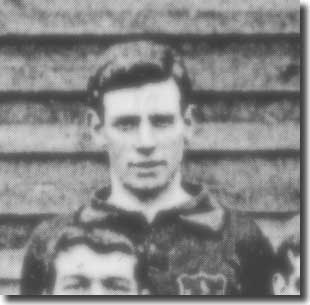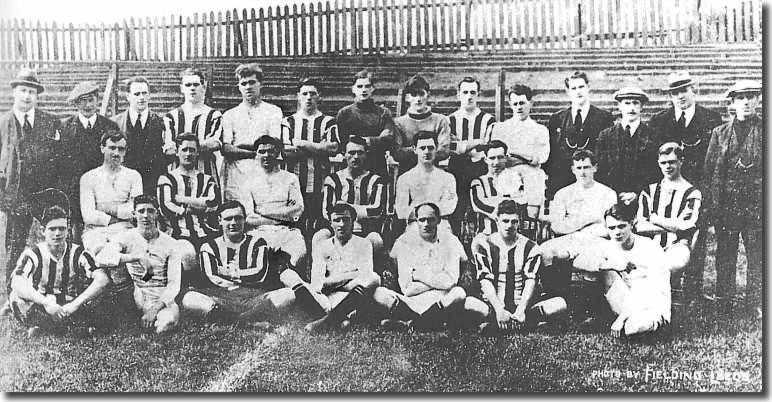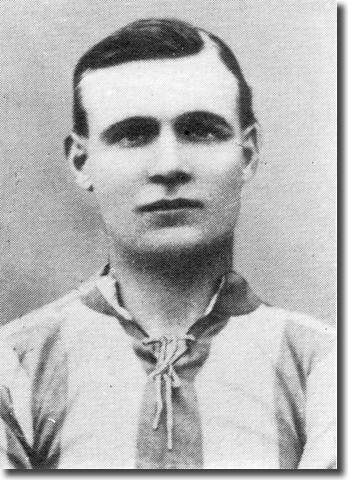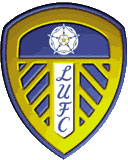 Results
and table
Results
and table
Before Leeds City were wound up
and expelled from the League in the
autumn of 1919, the club had built up a strong and loyal local following,
who were committed to the continuance of top class football in the area.
The same day as City's players were auctioned off, October 17 1919, a
meeting was held in the city to plan a way forward. It was attended by
more than 1,000 supporters, who were desperate to recover something from
the disaster.
Alf Masser, a local solicitor, was asked to chair the meeting, which
unanimously agreed a motion to form both a new professional club and a
supporters' club. Masser was one of seven men elected as the new club's
management committee, along with Joe Henry junior (son of the Lord Mayor
of Leeds, who had worked so hard to save City), Mark Barker, R.E.H. Ramsden,
Charles Snape and former players Dick Ray (who was appointed the first
manager of the club) and Charlie Morgan.
The newly formed Leeds United Association Football Club was invited to
join the Midland League by the secretary, Mr J Nicholson, replacing Leeds
City Reserves on 31 October. The new club moved into Elland Road, taking
on the ground from Yorkshire Amateurs, who had been using it following
the demise of City, and then became Leeds United's first ever opponents,
losing 5-2 on 15 November 1919.
The week after that game, Leeds United began their delayed Midland League
campaign with a goalless draw against Barnsley Reserves. Sometimes that
season the club played friendly games on the same day as League fixtures,
with United fielding a weaker side to fulfil their formal obligations
while their stronger team gained experience against other sides. They
ended that season 12th in the Midland League.
For a time it looked like Huddersfield Town, who were in the process
of winning promotion to the First Division, might move to Elland Road
to amalgamate with the new club. Two directors at Huddersfield had demanded
that the club repay them the £40,000 they owed them. At the same
time, Huddersfield's chairman and benefactor, Hilton Crowther, was fast
becoming frustrated by the lack of interest being shown in Town by the
local public and offered to transplant his side to Elland Road. He wanted
to play the club's remaining fixtures at the ground, and with his players'
blessing entered into discussions with United's Board. The move would
have helped the debt to be repaid.
 The
Football League Management Committee endorsed Crowther's proposals. They
decreed that if Huddersfield Town could not raise the money needed to
pay off what the club owed by the end of the year, then Crowther's wish
would be granted. This ultimatum prompted the Town supporters to rally
round the club and eventually the proposals came to nothing. Huddersfield
Town went on to appoint former Leeds City boss Herbert
Chapman and to enjoy enormous success in the 1920's, winning a hat-trick
of League Championships. They ended the season as runners up to Aston
Villa in the Cup final.
The
Football League Management Committee endorsed Crowther's proposals. They
decreed that if Huddersfield Town could not raise the money needed to
pay off what the club owed by the end of the year, then Crowther's wish
would be granted. This ultimatum prompted the Town supporters to rally
round the club and eventually the proposals came to nothing. Huddersfield
Town went on to appoint former Leeds City boss Herbert
Chapman and to enjoy enormous success in the 1920's, winning a hat-trick
of League Championships. They ended the season as runners up to Aston
Villa in the Cup final.
Crowther had set his heart on building the new Leeds United, however,
and he became the new club chairman anyway, making the club a loan of
£35,000, repayable when United gained promotion to the First Division.
He brought with him the Huddersfield boss Arthur
Fairclough, who had won the FA Cup with his Barnsley side in 1912,
and was appointed Leeds manager on 26 February 1920. Dick
Ray became Fairclough's assistant for a while, but left the club in
1923.
Both Fairclough and Crowther were determined to drum up support for the
club's campaign to gain Football League status. They threw themselves
into the task, at the same time attempting to shape a team that could
successfully compete in second division football. Their powers of persuasion
were remarkable. On 31 May 1920, Leeds United were elected to the Second
Division. 'The promoters are to be congratulated on the energy and determination
they have shown,' commented the Yorkshire Post. 'Financial stability
seems already to be assured and the nucleus of a thoroughly capable side
has been secured. So good a case did Leeds United make, so effectively
had claims been canvassed by Mr Hilton Crowther and Arthur Fairclough,
that Leeds headed the poll with 31 votes.'
Fairclough recruited numerous players from local junior football clubs,
but also needed experienced professionals from whom they could learn.
Two key defensive signings were centre-half Jim Baker, who had served
Fairclough well at Huddersfield, a robust, hard tackling defender who
became Leeds United's first captain, and full-back Jimmy Frew from Hearts.
back to top
In preparation for their entry into the big time, Fairclough and Ray
scoured the country for talent and the club advertised for players in
local papers. Most of the new players were recruited from non-League clubs
in the North, such as winger George Mason from Frickley Colliery, but
Fairclough also signed forwards from Football League clubs such as Ernie
Goldthorpe (Bradford City), Jack Lyon (Hull City), Jerry Best (Newcastle
United), Len Armitage (Sheffield Wednesday) and George Hill (Rotherham).
During 1920/21, Fairclough added former Leeds City players Ivan Sharpe
and Tommy Lamph, who only played  a
handful of games, but thereby became the only two individuals to play
for both City and United. Towards the end of the season, frustrated by
a lack of goals, Fairclough paid out the then exorbitant fee of £1,750
to sign Bristol City's 30-year-old centre forward, Tommy Howarth. He came
good with six goals from eleven appearances including four in the final
four games.
a
handful of games, but thereby became the only two individuals to play
for both City and United. Towards the end of the season, frustrated by
a lack of goals, Fairclough paid out the then exorbitant fee of £1,750
to sign Bristol City's 30-year-old centre forward, Tommy Howarth. He came
good with six goals from eleven appearances including four in the final
four games.
The new era also ushered in a new image. The old City colours of blue
and old gold were replaced by the blue and white striped shirts and white
shorts of Huddersfield Town. The team that took the field for United's
first league match at Port Vale on 28 August 1920 was astonishingly young
and inexperienced. The eleven were made up of Billy Down, 20, goalkeeper
(from Ashington); Bert Duffield, 26, right-back (Castleford Town); Arthur
Tillotson, 17, left-back (Castleford Town); Robert Musgrove, 27, right-half
(Durham City); Baker, 28; Jimmy Walton, 16, left-half (West Stanley);
Mason, 19, outside-right; Goldthorpe, 22, inside-right; Bob Thompson,
centre-forward (Durham City); Lyon, 26, inside-left and Best, 19, outside-left.
It would have been a glorious revenge for Leeds City's tribulations if
United had overcome Port Vale, who had taken City's place after agitating
for their expulsion. However, the naive collection of youngsters lost
2-0, although the Yorkshire Post reported that there was 'evidence
of potential success in that Leeds overplayed their opponents in the first
half. The chief failing was among the forwards ... Ernest Goldthorpe was
the one success. The rear division ... was undoubtedly efficient ... Baker
is a centre-half of experience, intelligence and enthusiasm.'
Leeds United's first home game against South Shields drew a crowd of
16,958 to Elland Road. They lost, 2-1, as Len Armitage made history as
the scorer of United's first goal in League football; yet on the evidence
of two slender defeats, it seemed unlikely that Fairclough's team would
be overwhelmed in Second Division company.
Their third game, played before 15,000 at Elland Road, was one to savour:
a 3-1 win against the hated Port Vale, with two goals from Matt Ellson,
a signing from Frickley Colliery, and one from Best. There were few outstanding
teams in the division. Throughout the campaign Leeds, robbed of Goldthorpe's
services early on by injury, had struggled for goals. The season's most
emphatic victory, a 4-0 trouncing of Coventry on 1 December, was, according
to the Yorkshire Post, less notable for vibrant attacking play
than for Baker's towering performance. The ten away goals the side scored
remains the worst in the club's history. Thompson, who had joined from
Durham City, but had League experience previously with Preston, was the
top scorer with just 11 goals. He was also the first United player to
hit a hat trick, in the 3-0 win over Notts County in December.
The defence, however, was formidable with skipper Baker, full-back Bert
Duffield and goalkeeper Down all ever-present and outstanding. Baker was
an indomitable figure, the man of the season for the club, and played
in every league game, as he would do again in 1921/22. Centre-half Ernie
Hart, who was later to captain United and play for England, made his first
five league appearances for the club after Christmas.
United's maiden FA Cup campaign was a somewhat bizarre experience - because
of the expanded number of clubs in the League it was necessary to hold
qualifying rounds to get the numbers down to manageable proportions for
the first round proper, where 32 ties were held. United were entered at
the first qualifying round stage, as their promotion to the second tier
was agreed by election, rather than through promotion. They ripped through
Yorkshire minnows Boothtown and Leeds Steelworks, running up twelve goals,
with both games played on the same day as Second Division commitments,
requiring United to play reserve elevens, which included Hart. They scratched
from the third qualifying round and Harrogate were given a walkover. Inexplicably,
three Third Diivision sides (Merthyr Town, Newport County and Gillingham)
were entered at the fourth qualifying round. Five Third Division and four
Second Division sides were entered at the sixth qualifying round stage.
Leeds finished their first season 14th with 38 points from 42 matches
but, to put this into perspective, only 16 points separated Bristol City,
in third place, from Coventry, who were second from bottom. For Leeds,
survival was an achievement. Crowds averaged just under 16,000 which,
though well below Alf Masser's blithe predictions, was evidence of solid
interest.
It was a quiet start to their league history, but the club had successfully
left behind the ignominy of the Leeds City disaster and were ready to
go on to better things.
Other Football Highlights from 1920/21
- 1920/21 saw the arrival of the Third Division, as the Southern League's
First Division was accepted en bloc. The first champions were Crystal
Palace
- Burnley became league champions for the first time off the back of
a 30-match unbeaten run in the middle of the season following losing
all of their first three matches
- Tottenham Hotspur, who had won the Second Division title in 1920,
beat Second Division Wolves 1-0 on a quagmire of a pitch at Stamford
Bridge to win the FA Cup for the second time
- The FA raised the international match fee from £4 to £6
Results and table
back to top












 The
Football League Management Committee endorsed Crowther's proposals. They
decreed that if Huddersfield Town could not raise the money needed to
pay off what the club owed by the end of the year, then Crowther's wish
would be granted. This ultimatum prompted the Town supporters to rally
round the club and eventually the proposals came to nothing. Huddersfield
Town went on to appoint former Leeds City boss Herbert
Chapman and to enjoy enormous success in the 1920's, winning a hat-trick
of League Championships. They ended the season as runners up to Aston
Villa in the Cup final.
The
Football League Management Committee endorsed Crowther's proposals. They
decreed that if Huddersfield Town could not raise the money needed to
pay off what the club owed by the end of the year, then Crowther's wish
would be granted. This ultimatum prompted the Town supporters to rally
round the club and eventually the proposals came to nothing. Huddersfield
Town went on to appoint former Leeds City boss Herbert
Chapman and to enjoy enormous success in the 1920's, winning a hat-trick
of League Championships. They ended the season as runners up to Aston
Villa in the Cup final. a
handful of games, but thereby became the only two individuals to play
for both City and United. Towards the end of the season, frustrated by
a lack of goals, Fairclough paid out the then exorbitant fee of £1,750
to sign Bristol City's 30-year-old centre forward, Tommy Howarth. He came
good with six goals from eleven appearances including four in the final
four games.
a
handful of games, but thereby became the only two individuals to play
for both City and United. Towards the end of the season, frustrated by
a lack of goals, Fairclough paid out the then exorbitant fee of £1,750
to sign Bristol City's 30-year-old centre forward, Tommy Howarth. He came
good with six goals from eleven appearances including four in the final
four games. 